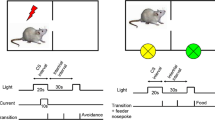Abstract
One purpose of the present experiment was to investigate the effects of exposure to fixed and variable duration inescapable shock on the subsequent acquisition of a shuttle escape response. Another purpose was to examine closely the behavior of animals during exposure to inescapable shock in an attempt to assess directly the behavioral changes occurring during this experience. Competing response accounts of the learned helplessness effect propose the mechanism of adventitious reinforcement during inescapable shock for the learning of low activity responses. Exposure to inescapable fixed duration shock should therefore be more effective than variable duration shock of the same average value in producing subsequent escape deficits. However, the present experiment demonstrated equivalent shuttle escape deficits resulting from the two types of shock exposure. In addition, behavioral observations made during inescapable shock indicated that those behaviors immediately preceding shock offset during the first several trials were not more likely to develop than other behaviors that were virtually absent early in the session. This pattern of results does not support current competing response hypotheses, but is in agreement with learned helplessness theory.
Similar content being viewed by others
References
ALTENOR, A., VOLPICELO, J. R., & SELIGMAN, M. E. P. (1979). Debilitated shock escape is produced by both short and long-duration inescapable shock: Learned helplessness vs. learned inactivity. Bulletin of the Psychonomic Society, 14, 337–339.
ANISMAN, H. (1975). Time-dependent variations in aversively motivated behaviors: Nonassociative effects of cholinergic and catecholaminergic activity. Psychological Review, 82, 359–385.
ANISMAN, H., DECATANZARO, D., & REMINGTON, G. (1978). Escape performance deficits following exposure to inescapable shock: Deficits in motor response maintenance. Journal of Experimental Psychology: Animal Behavior Processes, 4, 197–218.
BOLLES, R. C. (1970). Species-specific defense reactions and avoidance learning. Psychological Review, 71, 32–48.
BRACEWELL, R. J., & BLACK, A. H. (1974). The effects of restraint and noncontingent preshock on subsequent escape learning in the rat. Learning and Motivation, 5, 53–69.
DRUGAN, R. C., & MAIER, S. F. (1982). The nature of the activity deficit produced by inescapable shock. Animal Learning and Behavior, 10, 401–406.
GLAZER, H. I., & WEISS, J. M. (1976a). Long-term and transitory interference effects. Journal of Experimental Psychology: Animal Behavior Processes, 2, 191–201.
GLAZER, H. I., & WEISS, J. M. (1976b). Long-term interference effect: An alternative to “Learned Helplessness.” Journal of Experimental Psychology: Animal Behavior frocesses, 2, 202–213.
KELSEY, J. E. (1977). Escape acquisition following inescapable shock in the rat. Animal Learning and Behavior, 5, 83–92.
LEVIS, D. J. (1976). Learned helplessness: A reply and alternative S-R interpretation. Journal of Experimental Psychology: General, 105, 47–65.
MAIER, S. F., ALBIN, R. W., & TESTA, T. J. (1973). Failure to learn to escape in rats previously exposed to inescapable shock depends on the nature of the escape response. Journal of Comparative and Physiological Psychology, 85, 581–592.
MAIER, S. F., & JACKSON, R. L. (1979). Learned helplessness: All of us were right (and wrong): Inescapable shock has multiple effects. In G. H. Bower (Ed.), The psychology of learning and motivation (pp. 155–218). New York: Academic Press.
MAIER, S. F., & SELIGMAN, M. E. P. (1976). Learned helplessness: Theory and evidence. Journal of Experimental Psychology: General, 105, 3–46.
OVERMIER, J. B., & SELIGMAN, M. E. P. (1967). Effects of inescapable shock upon subsequent escape and avoidance behavior. Journal of Comparative and Physiological Psychology, 63, 23–33.
OVERMIER, J. B., & WIELKIEWICZ, R. M. (1983). On unpredictability as a causal factor in “Learned helplessness.” Learning and Motivation, 14, 324–337.
SELIGMAN, M. E. P., & BEAGLEY, G. (1975). Learned helplessness in the rat. Journal of Comparative and Physiological Psychology, 88, 534–542.
SELIGMAN, M. E. P., MAIER, S. F., & SOLOMON, R. L. (1971). Unpredictable and uncontrollable aversive events. In F. R. Brush (Ed.), Aversive conditioning and learning (pp. 347–401). New York: Academic Press.
VOLPICELLI, J. R., ULM, R. R., ALTENOR, A., & SELIGMAN, M. E. P. (1983). Learned mastery in the rat. Learning and Motivation, 14, 204–222.
WEISS, J. M., GLAZER, H. I., & POHORECKY, L. A. (1976). Coping behavior and neurochemical changes: An alternative explanation for the original “learned helplessness” experiments. In Relevance of the psychopathological animal model to the human (pp. 141–173). New York: Plenum Press.
Author information
Authors and Affiliations
Rights and permissions
About this article
Cite this article
Warren, D.A., Rosellini, R.A. & Plonsky, M. Regularity of Inescapable Shock Duration Affects Behavioral Topography, but not Shuttle Escape Performance. Psychol Rec 35, 227–238 (1985). https://doi.org/10.1007/BF03394929
Published:
Issue Date:
DOI: https://doi.org/10.1007/BF03394929




